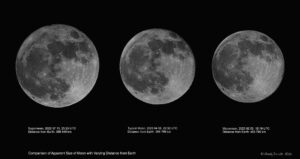July 1, 2023 | by Daniel Giamario |
Extreme Out-of-Bounds – Precursor to Standstill 2024
The remarkable Full Moon of 11Capricorn19 happens at 4:39am PDT / 11:40am UT on Monday morning, July 3. Sunday and Monday moonrises and moonsets are not to be missed. There are at least three features of this Full Moon to be aware of.
“Super” Full Moon
This is the first of four so called Super Full Moons in a row in 2023.
What are Super Full Moons?
It was the astrologer Richard Nolle who coined the term “Supermoon” in 1979. He defines a Supermoon as: a new or full moon which occurs with the moon at or near (within 90% of) its closest approach to Earth in a given orbit. Super Full Moons look brighter than ordinary full moons, by a noticeable amount. That’s because a Supermoon exceeds the disk size of an average-sized moon by up to 8% and the brightness of an average-sized full moon by some 16%. And then, it exceeds the disk size of a micro-moon (a year’s most distant and therefore smallest full moon) up to 14% and the brightness of a micro-moon by some 30%. Contrast these moon distances to the average moon distance of 238,900 miles / 384,472 km.

July 2-3: 224,895 miles / 361,934 km
August 1: 222,158 miles / 357,530 km
August 30-31: 222,043 miles / 357,344 km
Sept 28-29: 224,658 miles / 361,552 km
By the way, 2024 will have four full Supermoons in a row as well. They are August 19, September 18, October 17 and November 15.
The Full Moon of August 30-31, 2023, will be the closest Supermoon this year, being 222,043 miles / 357,344 km from Earth. The next time we’ll have a full Supermoon even closer than this is November 5, 2025, when the moon lies 221,817 miles / 356,980km from Earth.
Despite all that, it needs to be pointed out that TOTAMS has never fully adopted the currently popular “Supermoon” nomenclature nowadays used by astronomers and astrologers alike. Instead, we use the adjective “super” for eclipses – as they are amplified new and full moons! Prior to the current popular appropriation (from as astrologer, no less), astronomers used the terms perigean full and new moons.
Extreme Out-of-Bounds Moon
This Capricorn Full Moon will reach as far as 27S51 declination, a good 4 1/2 degrees south of the ecliptic. For about three days, as the Moon is near the Southern Solstice, a most remarkable viewing phenomenon can be witnessed: Being stationary near the June Solstice time of the year, the Sun has only reached 23N08 declination, still nearly identical to its North Solstice extreme. What this means is that the Moonrise and -set locations on the horizons will be extremely far South of due East for moonrise and extremely far South of due West at Moonset. The opposite applies to the Sun, which will rise nearly at its maximum North of East, and set near its maximum North of West. The physical experience of this can be startling and surprising when doing ceremony, and it gets more and more extreme the farther North or South of the tropics of Cancer and Capricorn you are. Remember this when observing this Full Moon!
I won’t repeat my interpretation of the OOB Moon here, but please use this link for info and the fun out-of-bounder survey.
Best viewing of the four 2023 Supermoons:
July 2-3 overnight
August 1 morning or evening
August 30-31 overnight
September 28-29 overnight
Precursor to The 2024 Callanish Lunar Standstill
The peak of the Lunar Standstill season of 2024-2025 is fast approaching. The Full Moons nearest to the June Solstice in 2024 and 2025 are the ones that “walk on the land” as seen from the Callanish site in Scotland. As many of you know, TOTAMS is having our annual gathering there, June 19-25, 2024. It turns out that the June 22, 2024, Capricorn Full Moon is a near exact match to this July 3, 2023, Capricorn Full Moon. In 2024, the Moon will be at its maximum southern declination of 28S21. Mercury and Venus will also be OOB then, as Mercury is now. But even more remarkable is that the 2024 Full Moon of 1Capricorn07 happens just 25 hours after the exact Solstice, even closer than this year. Thus, this year’s situation will be greatly amplified!
Clearly, this Full Moon is illuminating the way towards the Lunar Standstill season. Keep this in mind as you gaze on the Full Moon. And may the insights streaming in from Galactic Center and Galactic Edge show you the way!
For more on the Lunar Standstill, use this link: https://turningoftheages.com/event/lunar-standstill-seminar1/
